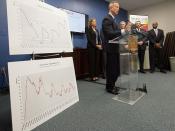The objective of full employment refers to the situation in which all people aged 15 and over who are both willing and able to find work are able to do so. In reality, we must allow for a small level of unemployment to exist, as to achieve an unemployment rate that is too low may result in negative consequences such as inflation. The Objective of full employment will be met when the governmentÃÂs aim of 5-6% percentage of the labour force is unemployed, and there is minimum cyclical unemployment but also a fairly low level of natural unemployment (ie frictional) is tolerated.
As a result, the goal for full employment is to maintain an unemployment rate that is as close as possible to the NAIRU. The NAIRU is the Non-Accelerating Inflationary Rate of Unemployment, a tool used by Treasury and the RBA to determine acceptable levels of unemployment. In simple terms, it is the lowest rate of unemployment that the Australian economy can sustain without leading to inflation.
This is also referred to as the ÃÂnaturalÃÂ rate of unemployment. Below NAIRU, economists believe that the economy is operating at full capacity with wage inflation likely to take hold and become a problem.
*Eg, If the rate of unemployment is 3%, labour will become in short supply, workers will be able to demand higher wages. Wage increases may result, causing cost inflation to increase. Therefore the 3% unemployment is considered to be outside the NAIRU acceptable range of employment.
*5-6% unemployment rate of the labour force is the governmentÃÂs aim. However, this goal changes to 4-5% depending on current economic situations, for example inflation.
*1960 : 2-3%= people were employed due to lack of level of technology compared to today. People in the industries were still regarded as important,


